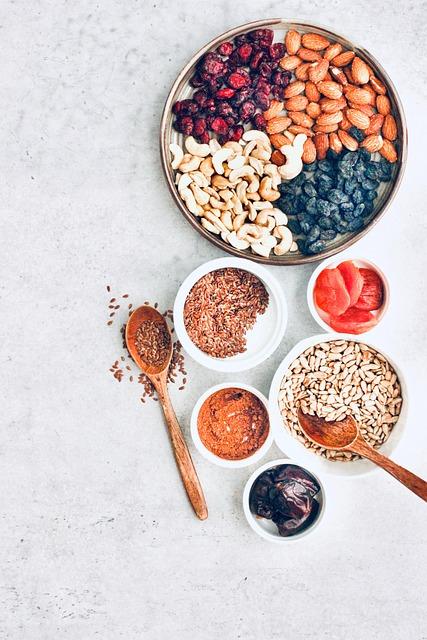Table of Contents
- Exploring the Microbial Universe of Kombucha Cultures
- The Role of SCOBY in Fermentation Process
- Visual Insights: What Kombucha Looks Like Under Microscopy
- Health Benefits Revealed: Understanding Probiotics in Kombucha
- Practical Tips for Brewing Your Own Kombucha at Home
- Q&A
- Final Thoughts


Exploring the Microbial Universe of Kombucha Cultures
The microbial universe of kombucha cultures is a fascinating tapestry woven from various microorganisms that work symbiotically. At the heart of this effervescent beverage is the SCOBY (Symbiotic Culture of Bacteria and Yeast), a gelatinous mass that teems with life. Under the microscope, you can observe a beautiful formation of yeasts and bacteria, primarily Acetobacter species and various Saccharomyces strains. These microorganisms ferment the sugars present in tea and produce not just carbonation, but also a multitude of beneficial compounds, including acids, vitamins, and enzymes.
Exploring the diversity within kombucha cultures reveals several key players that contribute to the drink’s health benefits and distinct flavors. Among them are:
- Brettanomyces: A yeast known for its funky flavor profile that adds complexity to kombucha.
- Lactobacillus: A bacteria that produces lactic acid, lending the drink its tangy taste and probiotic benefits.
- Gluconobacter: An acetic acid bacterium that converts alcohol into acetic acid, enhancing the sourness.
This plethora of microorganisms not only influences the flavor and aroma of kombucha but also contributes to its probiotic properties, making it a popular choice for gut health enthusiasts. To illustrate the contribution of different microorganisms, the following table highlights the primary strains found in kombucha, along with their characteristics:
| Microorganism | Type | Contribution |
|---|---|---|
| Brettanomyces | Yeast | Funky flavors, complex aromatic profile |
| Lactobacillus | Bacteria | Probiotics, tangy taste |
| Gluconobacter | Bacteria | Acetic acid production, enhanced sourness |
The Role of SCOBY in Fermentation Process
The star of the kombucha brewing process is undoubtedly the SCOBY, or Symbiotic Culture Of Bacteria and Yeast. This gelatinous mass not only floats on the surface of the tea but also encapsulates a diverse community of microorganisms. These microorganisms work in harmony to convert sweetened tea into the fizzy, tangy drink enjoyed by many. As these bacteria and yeast invigorate the fermentation process, they produce a myriad of compounds, contributing to the distinct flavor profile of kombucha.
During fermentation, the SCOBY performs several critical functions:
- Acid Production: The bacteria in the SCOBY generate acetic acid, leading to the signature tartness of kombucha.
- Carbonation Generation: Yeast consumes the sugars in the tea, producing carbon dioxide, which enhances the drink’s fizziness.
- Nutrient Synthesis: As fermentation progresses, beneficial compounds like B vitamins, enzymes, and probiotics are synthesized, elevating the health benefits of kombucha.
Understanding the composition of the SCOBY can provide deeper insights into the fermentation process. A simple table presenting the key microbial players in a typical SCOBY helps illustrate this diversity:
| Microorganism | Role in Fermentation |
|---|---|
| Bacteria | Convert sugars into acids, promoting tart flavor and probiotics. |
| Yeast | Ferments sugars into alcohol and carbon dioxide, adding carbonation. |
| Acetic Acid Bacteria | Regulates acidity and contributes to the distinct sour taste. |


Visual Insights: What Kombucha Looks Like Under Microscopy
When viewed under a microscope, kombucha unveils a fascinating world teeming with life and complexity. The most striking feature is the symbiotic colony of bacteria and yeast, commonly referred to as SCOBY. This gelatinous mass is not just a home for microorganisms; it’s a vibrant community that plays a crucial role in the fermentation process. Observing the SCOBY reveals a vast array of textures, ranging from smooth to irregular, and its interactive layers tell a story of the fermentation journey.
Delving deeper, one can discern various microorganisms swimming in the liquid, each contributing to the creation of that unique flavor profile kombucha is known for. The visible yeasts, often resembling tiny clusters or filamentous structures, are key players in alcohol production during fermentation. Bacteria, particularly acetic acid bacteria, appear as short rods or filaments, which help transform the alcohol into acetic acid, lending kombucha its characteristic tangy taste. This interaction between yeast and bacteria produces an ecosystem that thrives under the right conditions, all of which can be observed and studied through a microscope.
The color spectrum is equally fascinating, ranging from rich ambers to glowing greens depending on the tea used and the ingredients added during brewing. To illustrate the diversity found in kombucha, a simple table can highlight some of the key microorganisms identified under microscopic examination:
| Microorganism | Role in Fermentation | Appearance |
|---|---|---|
| Yeast (Saccharomyces cerevisiae) | Produces alcohol and carbon dioxide | Filamentous clusters |
| Bacteria (Acetobacter aceti) | Converts alcohol to acetic acid | Short rod shapes |
| Bacteria (Gluconobacter) |
Oxidizes ethanol to acetic acid | Tiny rods and filaments |
This microscopic glimpse into kombucha not only enhances our understanding of its fermentation process but also broadens our appreciation for this effervescent tea. From the microbial activity to the intricate textures and colors, the visual insights provided by microscopy reveal the intricate dance of life occurring within each batch, making every sip of kombucha a unique experience.


Health Benefits Revealed: Understanding Probiotics in Kombucha
When exploring the world of kombucha, one of the standout features is its abundant probiotic content. These beneficial bacteria are essential for maintaining a healthy gut microbiome and are crucial for digestive health. Probiotics can help break down food, absorb nutrients, and fend off harmful bacteria that can disrupt the digestive system’s delicate balance. Regular consumption of kombucha may contribute to improved gut health, leading to benefits such as reduced bloating and enhanced nutrient absorption.
Beyond digestive benefits, probiotics in kombucha also play a significant role in enhancing the immune system. A robust gut microbiome supports overall immunity, which can lead to a decreased frequency of illnesses and infections. Probiotics help in the production of antibodies and promote the activity of immune cells. This connection highlights the importance of incorporating fermented foods like kombucha into a balanced diet to bolster your body’s natural defenses.
Additionally, there’s emerging evidence suggesting that probiotics can have a positive impact on mental health. The gut-brain axis illustrates how gut health can influence mood and cognitive function. Regular intake of kombucha may contribute to reduced symptoms of anxiety and depression. Here’s a brief overview of the potential health benefits derived from probiotics found in kombucha:
| Health Benefit | Description |
|---|---|
| Digestive Health | Improves gut health, reduces bloating, and aids in nutrient absorption. |
| Immune Support | Enhances immune system function, leading to decreased illness frequency. |
| Mental Well-being | May improve mood and reduce symptoms of anxiety and depression. |


Practical Tips for Brewing Your Own Kombucha at Home
Brewing your own kombucha at home can seem daunting at first, but with a few practical tips, you can create a delicious and effervescent result that rivals store-bought options. Start with quality ingredients: use organic tea (black, green, or herbal) and pure cane sugar, as they are essential for the fermentation process. Make sure to have clean equipment, as sanitation is key to preventing unwanted bacteria buildup. Here are some tips to ensure success:
- Temperature Control: Maintain a warm environment (around 75-85°F) for optimal fermentation.
- Tea Varieties: Experiment with different teas and flavorings to find your perfect balance.
- SCOBY Care: Keep the SCOBY healthy by using it regularly; it thrives on consistent use.
Fermentation time is crucial to achieving the desired flavor and effervescence. Typically, the first fermentation lasts between 7-14 days, depending on your taste preferences. Use tasting samples throughout this period to determine when it’s just right for you. For a fizzier finish, consider a second fermentation with fruits or spices in sealed bottles. Here’s a simple overview of the fermentation timeline:
| Day | Activity | Tasting Notes |
|---|---|---|
| 1-3 | Set up initial fermentation. | Very sweet, flat. |
| 4-7 | Monitor bubbly formation. | Balanced sweet and tangy. |
| 8-14 | Decide on bottling. | Tart and slightly effervescent. |
flavoring your kombucha can elevate it to new heights. The second fermentation is your chance to be creative! Consider using combinations like ginger and lemon or strawberry and basil. Simply add your ingredients to the bottles before sealing them and leave them at room temperature for a few days to carbonate. Below are some flavor ideas to inspire your next brew:
- Grapefruit and Rosemary
- Mango and Chili
- Cucumber and Mint
Q&A
Q&A: Exploring Kombucha Under the Microscope
Q1: What is kombucha, and why is it popular? A1: Kombucha is a fermented tea beverage made by combining sweetened tea with a symbiotic culture of bacteria and yeast (SCOBY). Its popularity has surged due to its tangy flavor and potential health benefits, such as improved digestion, increased energy, and even enhanced immune function.Q2: What can we expect to see when examining kombucha under a microscope? A2: When viewed under a microscope, kombucha reveals a fascinating world of microorganisms. You might observe various shapes and sizes of bacteria and yeast cells, some of which may resemble tiny spheres or long, filamentous structures. The SCOBY itself can also be seen, showcasing its layered texture and gelatinous appearance, often full of tiny bubbles.
Q3: What types of microorganisms are commonly found in kombucha? A3: Kombucha typically hosts a variety of microorganisms, including Lactobacillus (a type of bacteria), Acetobacter (which helps in the fermentation process), and various yeast species like Saccharomyces. Each plays a crucial role in the fermentation process, contributing to the drink’s flavor, carbonation, and probiotic properties.
Q4: How does the fermentation process influence the microbiology of kombucha? A4: The fermentation process transforms sweetened tea into kombucha by allowing the SCOBY’s microorganisms to metabolize the sugars, producing acids, gases, and alcohol. This not only enhances the flavor, giving it that signature tang, but also alters the microbial composition, leading to a dynamic and evolving mixture of beneficial bacteria and yeasts over time.
Q5: What are the health implications of consuming kombucha rich in microorganisms? A5: Consuming kombucha may introduce beneficial probiotics into your gut, which can promote digestive health and maintain a balanced microbiome. However, individual responses can vary, and while many people enjoy health benefits, others may experience digestive discomfort. It’s always wise to start with small amounts, especially for those new to fermented foods.
Q6: Can examining kombucha under a microscope enhance our understanding of fermentation? A6: Absolutely! Microscopic analysis allows enthusiasts and researchers alike to visualize the complex interactions between various microorganisms during fermentation. This can deepen our understanding of how flavors develop, how probiotics function, and how different brewing conditions can affect the final product.
Q7: How can one safely explore kombucha microbiology? A7: For those interested in exploring kombucha under the microscope, using a home microscope kit with appropriate slides is a great start. Ensure that all equipment is sterilized to avoid contamination. Additionally, observe samples from different stages of fermentation for a more comprehensive view of the microbial activity. — Feel free to ask any additional questions if you’d like to dive deeper into the fascinating world of kombucha and its microscopic marvels!
